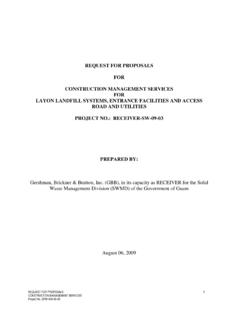Transcription of REQUEST FOR - Shive-Hattery
1 Which one do I use? REQUEST FOR QUALIFICATIONS OR REQUEST FOR PROPOSALBy Steve Davis, AIAPage 2 Having been in the architectural field for over 30 years, I have had opportunity to respond to several RFQs ( REQUEST for Qualifications) and RFPs ( REQUEST for Proposals). Often, there seems to be confusion about which one to use. This article will help you clarify when to use an RFQ or FOR QUALIFICATIONSAn RFQ ( REQUEST for Qualifications) is a qualifications-based selection process. It is NOT a bid. It is a REQUEST for firms to submit their qualifications to be considered for a project. It is applicable for professional services (similar to legal services) where a city or county is not required to take competitive bidsIn some states, it is not required for RFQs to be advertised.
2 Check with your legal counsel for what is allowable in your intent of an RFQ is to allow you to select who you feel is the most qualified for your project. You do have the opportunity to negotiate a fee with your final selection. If you cannot come to terms, you always have the option to go to your second or third choice. This is an appropriate method of soliciting for various professional services including architectural, engineering, and construction management FOR PROPOSALSAn RFP ( REQUEST for Proposals) is a REQUEST for firms to submit their proposal for a project. It is applicable for goods or services where a city or county is required to take competitive bids resulting in a final product/building.
3 Check with your legal counsel for what is allowable in your intent of an RFP is to allow you to select the most qualified company at the best price for your project. RFPs for services typically involve more than a price REQUEST including a company s history, capabilities, and financial information. This is an appropriate method to solicit construction services including general contractor, design-builder, and construction management at-risk. Frequently RFPs will include the phrase best-lowest, which allows the owner to consider more than just the lowest considering RFP/Bid response in a public setting, you must have a strong reason not to select the lowest bidder past performance problems, litigation, etc.
4 You typically cannot decide to go with the second lowest proposal/bid because they re the local or some other reason. Check with your legal counsel for what is allowable in your WOULDN T I ASK FOR A FEE FOR PROFESSIONAL SERVICES?The old adage holds true here and you get what you pay for. Professional fees are pretty competitive, and a small percentage of the overall life of a project. If you REQUEST a fee in your solicitation, professional service providers will look to limit the services they ll provide to keep their costs down and win the project. This can often results in more change orders and ultimately higher construction Charles Nelson s Cutting Designs Fees Raises Construction Costs article, research shows 93% (contractors) indicated that design and documentation quality did influence the price submitted for a tender (bid), while 75% indicated that it also had an influence on the time allowed for a project.
5 Later in the same article, Nelson shows that an extra in architectural fees can result in as much as 7-11% decrease in construction costs. 1 Architectural fees are competitive and as a result, the average fee range an owner might expect can easily be found. Once you know that, you have a baseline range of what might be a fee you could expect from your architect. Now you can go about selecting the best architect for your VS. RFP: WHICH ONE DO I USE?Page 3 RFQ VS. RFP: WHICH ONE DO I USE?HOW DO I FIND THE MOST QUALIFIED ARCHITECT FOR MY PROJECT? REQUEST architects to submit their qualifications to do your project.
6 Review the submittals, call references, and do online research to see if there are any skeletons in the closet. After doing your due diligence, narrow the choice down to a few you d like to interview. You want to make sure you can get along with and trust your selection. A face-to-face meeting can provide you a more subjective GOES IN AN RFQ?There are online templates for writing RFQs, and often times your local architect may be able to provide you a sample to edit, but the main components are the following:COVER LETTER At a minimum, state who is making the REQUEST , what services are being requested, and submittal deadline date for qualified firms to submit their responsesRFQ BODYG eneral Instructions outlining: REQUEST : Repeat of cover letter s information including who and what is being requested Schedule: Date submittals are due, date for selecting shortlisted firms, date for potential interviews, and date for decision Fee.
7 The following verbiage, or something similar to, should be included: The owner name will begin contract negotiations with the firm determined to be the most qualified. In the event that a contract cannot be negotiated with the first firm, the owner name reserves the right to negotiate with the next qualified firm(s) until a contract can be reached. Submittal Instructions stating: Number of copies and/or electronic submittals required Submittals to be delivered in sealed envelope marked Name of Project Name and address submittals are to be sent to Questions to be submitted in writing to contact name at contact information Statement of Scope stating specific service(s) being requested: Outline of the scope of services being requested.
8 Best if this can be done in a bullet/outline format. This allows responders to better organize their submittal and is easier for reviewers to critique, as it provides for an apples-to-apples FOR QUALIFICATIONS Qualifications-based selection process NOT a bid For professional services where a city or county is not required to take competitive bids Allows you to select who you feel is the most qualified for your project Negotiate a fee with your final selection. If you cannot come to terms, you always have the option to go to your second or third choice. Use to solicit for various professional services including architectural, engineering, and construction management agencyRFPREQUEST FOR PROPOSAL REQUEST for firms to submit their proposal for a project For goods or services where a city or county is required to take competitive bids resulting in a final product/building Allows you to select the most qualified company at the best price for your project More than a price REQUEST Use to solicit construction services including general contractor, design-builder, and construction management at-riskPage 4 RFQ VS.
9 RFP: WHICH ONE DO I USE?Submittal Content, listing items by section to be included in the submittal, for review. Listing by section helps responders organize their submittal and makes it easier for reviewers to critique. You may want to include a page limit for the submittal in the Submittal Content section to make it easier for responders and reviewers. Suggested Submittal Content may include: Cover Letter (one page) Section 1: Identify Firm(s) including name, address, phone number and contact person regarding this RFQ (one page) Section 2: Provide an organizational chart identifying disciplines, specific personnel, and role of those who will be assigned to this project (one page) Section 3: Describe your project approach for this project (two pages) Section 4: Firm s capacity ( number of full-time licensed architects).
10 Provide resumes and workload for people assigned to this project-refer to staff listed in Section 2. (maximum one page per person) Section 5: Detail firm s quality control process with regard to design, document control, and construction administration (one page) Section 6: Firm s litigation history and ask, Do you have any pending litigation or binding arbitration with a client? (one page) Section 7: Copy of your firm s current professional liability or errors and omissions insurance (one page) Section 8: List firms last five (5) similar projects including size, location, and contact person (maximum 5 pages) Section 9: Describe what makes your firm uniquely qualified for this project (one page) WHAT GOES IN AN RFP?







